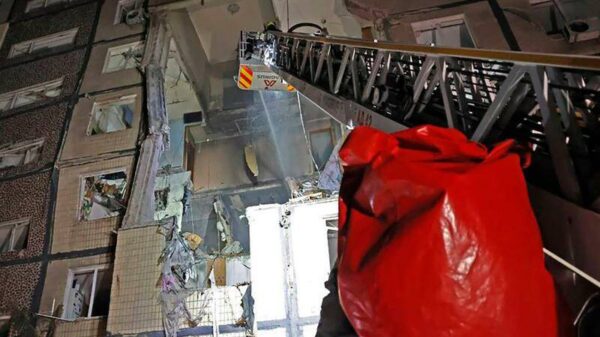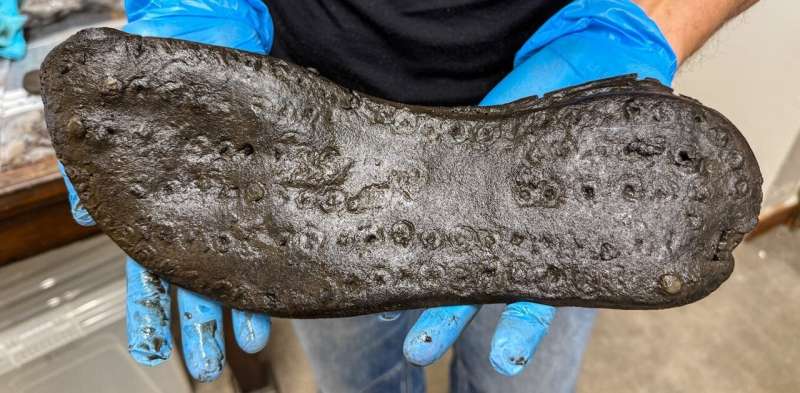Excavations at the Roman fort of Magna, located near Hadrian’s Wall in Northumberland, have led to the discovery of unusually large leather shoes. This find has captured the attention of archaeologists and the public alike, generating discussions about the implications of such footwear in Roman history.
The preservation of these shoes can be attributed to the favorable conditions of the waterlogged soil in the area. Such environments with low oxygen levels create ideal circumstances for organic materials, including leather, to remain intact over time. Excavations at Vindolanda, a site south of Hadrian’s Wall, have previously yielded a substantial collection of Roman footwear, allowing researchers to gain insights into the types of shoes worn by both soldiers and civilians.
The shoes from Magna are notable for their size. While large shoes have also been found at Vindolanda, less than 0.4% of those excavated there are classified as big. In contrast, the collection from Magna shows a significantly higher proportion of larger footwear. The largest shoe measures an impressive 12.8 inches in length, which corresponds to a modern UK shoe size of approximately 12 to 14. This raises intriguing questions about the individuals who wore them.
Archaeologist Emma Frame, who is involved in the Magna excavations, speculates on the possible reasons for the larger shoe sizes. “We have to assume it’s something to do with the people living here, having bigger feet, being potentially taller, but we don’t know,” she stated. This hypothesis suggests that some members of the military community at Magna may have been exceptionally tall. However, the lack of comprehensive studies on the Roman cemeteries in the Hadrian’s Wall area limits our knowledge of the average height of individuals from this period.
Alternative explanations for the oversized shoes have also been proposed. Some researchers wonder if these shoes could have served a practical purpose, such as providing extra space for additional layers of padding or thick socks. A letter from the Vindolanda site mentions a gift of socks and undergarments sent to soldiers, indicating the necessity of warmth during harsh winter conditions.
Additionally, historical records indicate that Syrian archers were stationed at Magna, a group not accustomed to the cold climate of northern England. This raises the possibility that the larger shoes were designed to help these soldiers cope with the frigid temperatures.
Another compelling theory suggests a medical purpose for the oversized footwear. The shoes may have been crafted for individuals experiencing swollen feet or those requiring medical dressings. Such hypotheses reflect the ongoing nature of archaeological research, where each discovery prompts further investigation and debate.
Frame emphasizes that while these theories are intriguing, they are not definitive answers. “I’m simply putting out some hypotheses that could explain the extra-large shoes based on other evidence we have and potential logical explanations,” she remarked. The essence of archaeology lies in formulating and testing various hypotheses to arrive at the most credible interpretations of the past.
The excitement surrounding new archaeological finds often leads to sensationalized headlines, with phrases like “baffled archaeologists” capturing public attention. While this language can enhance interest, it may misrepresent the nature of archaeological work, which is rooted in meticulous, evidence-based analysis. The challenge for archaeologists is not a lack of expertise but rather the fragmentary nature of historical evidence. Much of what exists from the past has been lost to time, and the artifacts we recover represent only a fraction of a more extensive narrative.
Interpreting these fragments is akin to assembling a complex jigsaw puzzle, where many crucial pieces may be missing. Sometimes, archaeologists possess enough information to form a clear picture; at other times, they must propose various theories and await further discoveries to fill in the gaps.
The ongoing excavations at Magna, alongside the rich history of Hadrian’s Wall, continue to provide valuable insights into the lives of the Roman Empire’s inhabitants. As research progresses, the conversation about the significance of these large shoes will undoubtedly evolve, contributing to our understanding of the past.


































































